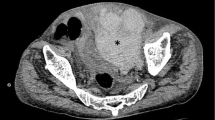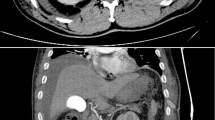Abstract
Spontaneous abdominal wall hematomas are relatively rare and mainly attributed to anticoagulation and severe cough. Despite the high incidence of anticoagulation-related bleeding complications, there are no reports of spontaneous abdominal wall hematomas during extracorporeal membrane oxygenation (ECMO). We report a case of a spontaneous rectus sheath hematoma caused by alternation of the lateral semi-prone position during ECMO in a 76-year-old female patient with severe acute respiratory distress syndrome. Unfractionated heparin 12,000–14,000 units/day was administered for anticoagulation during ECMO. From Day 6 of ECMO, the patient who was under deep sedation was alternately placed in the left and right lateral semi-prone positions every 4 h, for approximately 20 h per day. On Day 12 of ECMO, the patient developed hypotension with anemia and a palpable mass in the right lower abdomen. Abdominal ultrasonographic imaging revealed a huge echo-free space centered in the right lower abdomen. Emergency contrast-enhanced computed tomography (CT) scanning showed extravasation from the superior and inferior epigastric arteries as well as a rectus sheath hematoma. Despite no apparent contrast leakage, an inferior epigastric artery embolization was undertaken because the patient was on ECMO. On Day 13 after ECMO initiation, ECMO and anticoagulation were discontinued. On CT scanning a week later, the hematoma had reduced. In conclusion, spontaneous abdominal wall hematoma is a rare and important complication that might occur during ECMO. Thus, careful physical examination should be routinely conducted when the patient is semi-prone during ECMO.


Similar content being viewed by others
References
Sheth HS, Kumar R, DiNella J, Janov C, Kaldas H, Smith RE. Evaluation of risk factors for rectus sheath hematoma. Clin Appl Thromb Hemost. 2016;22:292–6.
Peek GJ, Mugford M, Tiruvoipati R, Wilson A, Allen E, Thalanany MM, Hibbert CL, Truesdale A, Clemens F, Cooper N, Firmin RK, Elbourne D, CESAR trial collaboration. Efficacy and economic assessment of conventional ventilatory support versus extracorporeal membrane oxygenation for severe adult respiratory failure (CESAR): a multicentre randomised controlled trial. Lancet. 2009;374:1351–63.
Combes A, Hajage D, Capellier G, Demoule A, Lavoué S, Guervilly C, Da Silva D, Zafrani L, Tirot P, Veber B, Maury E, Levy B, Cohen Y, Richard C, Kalfon P, Bouadma L, Mehdaoui H, Beduneau G, Lebreton G, Brochard L, Ferguson ND, Fan E, Slutsky AS, Brodie D, Mercat A, EOLIA Trial Group, REVA, ECMONet. Extracorporeal membrane oxygenation for severe acute respiratory distress syndrome. N Engl J Med. 2018;378:1965–75.
Bartlett RH. Extracorporeal membrane oxygenation for acute respiratory distress syndrome: EOLIA and beyond. Crit Care Med. 2019;47:114–7.
Guerin C, Reignier J, Richard JC, Beuret P, Gacouin A, Boulain T, Mercier E, Badet M, Mercat A, Baudin O, Clavel M, Chatellier D, Jaber S, Rosselli S, Mancebo J, Sirodot M, Hilbert G, Bengler C, Richecoeur J, Gainnier M, Bayle F, Bourdin G, Leray V, Girard R, Baboi L, Ayzac L, PROSEVA Study Group. Prone positioning in severe acute respiratory distress syndrome. N Engl J Med. 2013;368:2159–68.
Guervilly C, Prud'homme E, Pauly V, Bourenne J, Hraiech S, Daviet F, Adda M, Coiffard B, Forel JM, Roch A, Persico N, Papazian L. Prone positioning and extracorporeal membrane oxygenation for severe acute respiratory distress syndrome: time for a randomized trial? Intensive Care Med. 2019;45:1040–2.
Mazzeffi M, Greenwood J, Tanaka K, Menaker J, Rector R, Herr D, Kon Z, Lee J, Griffith B, Rajagopal K, Pham S. Bleeding, transfusion, and mortality on extracorporeal life support: ECLS Working Group on Thrombosis and Hemostasis. Ann Thorac Surg. 2016;101:682–9.
Brodie D, Slutsky AS, Combes A. Extracorporeal life support for adults with respiratory failure and related indications: a review. JAMA. 2019;322:557–68.
Peris A, Zagli G, Cianchi G, Lazzeri C, Sani G, Bonizzoli M. Iliopsoas haematoma: unexpected life-threatening complication during extracorporeal membrane oxygenation support in H1N1-induced acute respiratory distress syndrome patients. Br J Anaesth. 2011;107:819–20.
Cherry WB, Mueller PS. Rectus sheath hematoma: review of 126 cases at a single institution. Medicine. 2006;85:105–10.
Ozlu MF, Ayhan SS, Ozturk S, Erdem A, Yazici M. Abdominal wall hematoma related to severe cough in a patient under antiaggregant and anticoagulant therapy. Intern Emerg Med. 2012;7:S157–8.
Takahashi K, Nihei T, Aoki Y, Nakagawa M, Konno N, Munakata A, Okawara K, Kashimura H. Spontaneous rectus sheath hematoma associated with warfarin administration: a case report. J Rural Med. 2019;14:245–8.
Ariyoshi Y, Naito H, Ihoriya H, Yumoto T, Fujisaki N, Tsukahara K, Yamada T, Mandai Y, Osako T, Nakao A. Case of nontraumatic rectus sheath hematoma from muscle training mimicking acute abdomen. Case Rep Emerg Med. 2019;2019:3158969.
Hatjipetrou A, Anyfantakis D, Kastanakis M. Rectus sheath hematoma: a review of the literature. Int J Surg. 2015;13:267–71.
Contrella BN, Park AW, Wilkins LR, Sheeran D, Hassinger TE, Angle JF. Spontaneous rectus sheath hematoma: factors predictive of conservative management failure. J Vasc Interv Radiol. 2020;31:323–30.
Acknowledgements
I would like to thank all the doctors, nurses, clinical engineers, and other co-workers who were involved in the provision of medical care and support to this patient.
Author information
Authors and Affiliations
Contributions
All authors helped care for the patient. The first draft of the manuscript was written by YH and TY and all authors commented on previous versions of the manuscript. All authors read and approved the final manuscript.
Corresponding authors
Ethics declarations
Conflict of interest
The authors declare that they have no conflict of interest.
Informed consent
Written informed consent was obtained from the family of the patient for the publication of this case report and the accompanying images.
Additional information
Publisher's Note
Springer Nature remains neutral with regard to jurisdictional claims in published maps and institutional affiliations.
Rights and permissions
About this article
Cite this article
Hara, Y., Yatabe, T., Komatsu, S. et al. A case of spontaneous rectus sheath hematoma induced by lateral semi-prone positional changes during extracorporeal membrane oxygenation. J Artif Organs 24, 282–286 (2021). https://doi.org/10.1007/s10047-020-01202-y
Received:
Accepted:
Published:
Issue Date:
DOI: https://doi.org/10.1007/s10047-020-01202-y




